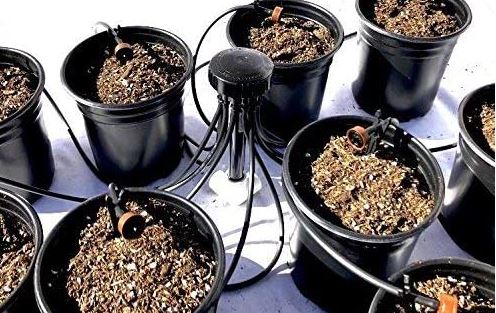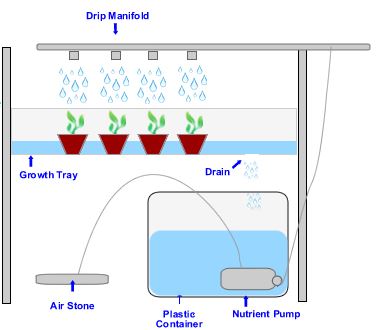How to Build a Drip Hydroponics System
by Kevin
Drip hydroponics systems are the most widely used around the World, because they’re efficient, safe and cost effective. If you’re planning on building a homemade hydroponics system based on the drip concept, you’re in the right place, because this article discusses just that.
If you’ve checked out the guide for building an ebb and flow hydroponics system then understanding how a drip system works should prove easy enough.
Actually, the distinction between ebb and flow systems and drip systems isn’t all that big, but those few small disparities make for quite a huge difference. Let’s take a look at how the drip system works and what components you’ll be needing for it.
Drip Hydroponics System – How it Works

A drip hydroponics system has a very similar structure to an ebb and flow one, in that a growth tray is suspended on top of a reservoir filled with water and nutrient solutions. A pump is placed inside the reservoir and connected to the growth tray, just like in an ebb and flow.
But here’s where the similarities stop and there are two major factors that takes the drip system into another category: the growth tray is not filled with flowing nutrient solution, but with a growth media that can retain water and the nutrient pump is “choked” with the help of a manifold, so that it doesn’t send nutrients to the growth tray in a constant flow, but rather in short drips.
This makes the drip hydroponics system a lot safer than ebb and flow ones, since the latter can easily flood the greenhouse or your home in case the drainage system fails.
Drip Hydroponics System – Components
You can purchase some of the components from your local store (Home Depot, Walmart, etc) or order them online from a recommended hydroponics store.
- A growth tray – a container that can hold enough growth media to keep your plants comfortable and also allow a bit of extra height for water, in the odd case it doesn’t get absorbed right away.
- A nutrient drip pump – the pump is placed inside the container, sending nutrient solutions and water to the drip manifold.
- A drip manifold – this manifold is placed on top of the growth tray and is connected to the nutrient pump. When it receives water from the pump, it sprays it over the plants and their growth media.
- A flow/drain system – this is used to recycle any water that doesn’t get absorbed by the plants. Make sure the drain system is placed straight on top of the container, so it doesn’t spill.
- A container – any solid container will do in the role of the nutrients reservoir, as long as there’s enough space to place the pump, an air stone and of course, the water in it. Plastic or plastic-coated metal or wood are good options for the container.
- An air pipe – this pipe will be positioned outside the container and you’ll need to connect it to the air stone. The air pipe’s role is to oxygenize the water.
- An air stone – used in conjunction with the air pipe, the air stone is used to oxygenize the water in the nutrient container.
Drip Hydroponics System – How to Build It
If you find the process of building your own system too difficult, consider buying one of our recommended hydroponic systems.

Fill your tray with your grow media of choice, then position the nutrient manifold in it and connect it to the water pump.
Place the air stone in the reservoir and connect it to the air pump, then set up the timers on the two pumps.
Make sure the manifold works correctly and indeed only a few drips get sprayed on the plant tray, otherwise you risk flooding your hydroponic system’s surroundings.
Last but not least, place the plants in the growth media and you’re good to go!
Drip Hydroponics System – Building Difficulty
Since the drip system is quite similar to the ebb and flow (which is one of the easiest to build) you might be tempted to say that it’s also easy to set up. That’s not completely incorrect, however it is harder to set a drip system than an ebb and flow one, mainly because you have to add two extra “components”, namely the grow media and the nutrient manifold.
So it would be fair to say that building a drip hydroponic system is slightly more difficult than building an ebb and flow or a water culture one, but it’s definitely easier than setting up several other types of hydroponic systems, such as aeroponic ones.
Thoughts on "How to Build a Drip Hydroponics System"
 |
 |
 |
 |
Hydroponics Tips